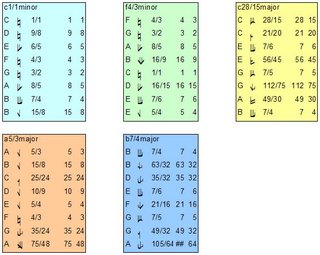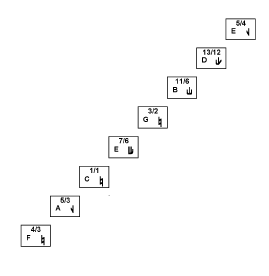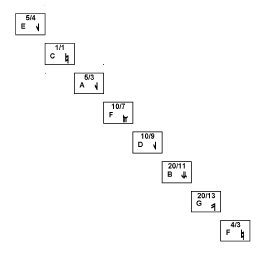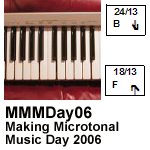
This is a work in progress...
Added an opening half measure and more second flute parts.
Microtonal Music is music using more than 12 tones per octave. I compose music using Csound and a preprocessor I wrote in Turbo Pascal. I post small updates as the compositions are being created, and a few final versions once I'm done. I strive towards music that could be played if we had the instruments capable of playing the notes. Think of it as "fake but accurate".

This is a work in progress...
You have to have the service, which is great if you like other people's music and are willing to sit at your computer and listen, neither of which I am. But, you never can tell when you might be at someone's house who pays the $10-15 dollars a month to have unlimited access to music at their computers. I only listen to music while I walk, or if my kids are playing. That's why I prefer podcasts. But that's just me. This experiment with 33 versions of Naima has been terrific. I highly recommend it if you can spend the time. I only listened to the first 24 bars or so of each. Can you imagine what Barry White could have done with this song if had set his mind to it? Breathless...

This is a work in progress...

This is a work in progress...


This is a work in progress...

The overtones go up and to the right, the undertones go down and to the right. Go down the undertone series from C 1/1 to A 8/5 to F 4/3. Then you can go up the overtone series on F 4/3. This would make a sort of major scale.

But consider another major scale hidden inside the diamond. Go up the overtone series from C 1/1 to E 5/4, then down the undertone series from there to the right. Pull out another "major" scale that uses the notes shown below on the right, in the order listed on the left.
This is a scale that also has a lot of material. You have a solid just major third and fifth, providing the traditional just 4:5:6 of the overtone scale. Then you have two different seconds, a major and a minor, neither of which are like to 12 tone equal major or minor seconds. The sixth is a sweet minor third (6:5) below the root. If you need it, there is a minor third chord based on A 5/3, C 1/1, E 5/4 inside the scale. The fourth note in the scale has the sting of the 11th undertone. The seventh is the traditional 15:8 above the root, for those major seventh heaven moments.


In part two of the Microtonal Music Day 2006 podcast, we're going to hear from 12 more microtonal composers, in another feast of microtonality. As I said in yesterday's installment, this podcast is a result of the efforts of dozens of composers and musicians who feel that microtonal music deserves wider recognition. The idea was hatched on the Making Microtonal Music Yahoo Groups mailing list, and has grown thanks to the efforts of that group. The idea is to pick a day, and just "flood the zone" with microtonal music, compose, play, share, and get someone to listen to microtonal music. Of course, we should do this every day, but today is an opportunity to really focus. Think of it as the black history month for microtonality.
Table of Contents:
First up is a piece by Rick McGowan which he calls:
a "Five Minute Symphony in 15-tet" consisting of 3 shortAs with almost all of today's microtonal composers, Rick uses a computer to control the pitch. Others in today's podcast use Csound, and other programs. When performers are able to play in tune in these challenging intonation systems, perhaps we can hear more live performances. But until then, we have the computer realizations.
movements. It is realized with Garritan Personal Orchestra with
microtuning courtesy of Fractal Tune Smithy.
Of course the tuning is 15 tone equal. It's scored for a small orchestra
consisting of winds & brass in ones, piano, and strings.
Blurb: Here's a bit of MACROtonal music for you all. The Tonalsoft encyclopedia lists 5-EDO as "the smallest cardinality EDO which has any real musical usefulness," And that sounds like a challenge if I ever heard one. 2 metallophones and a flute, in 4-EDO. Public Domain. 55 seconds long.Throwing down the gauntlet, I'd say. Here is the only 4 tone equal temperment piece in the known repertoire, Nothing of any Importance Suite by Rosencrantz the Sane.
Play clip.
The next piece was submitted by Yahya Abdal-Aziz, who brings a rich heritage of Middle Eastern tuning systems to his composition. The piece is called "Bunga Seroja". This performance is a collaboration between Yahya, who wrote the music, and John Lyle Smith who performed it. Yahya writes to offer his music to the group:
I have the pleasure to announce a tiny submission, my arrangement of a traditional Malay tune, performed by Jon L Smith and his Electric Light Orchestra (and with a subtle, slight imperfection inserted by myself, since as we all know, it is the height of hubris for mere mortals to believe they can attain to perfection in any sphere).Listen now to "Bunga Seroja" by Yahya Abdal-Aziz.
I thought, no matter how bad things are, how could I pass by a day in honor of the music of the very list I helped start? It would be churlish and desultory, and what better reason to stay up until 4:30 in the morning? (not to mention that I spent the earlier part of the evening accompanying Marvin Hamlisch. I keep wondering: what did I do in a previous life to deserve this?)Now listen to "Do Something", by Jon Szanto.
OK, so we have just a couple minutes of cruft entitled "Do Something". I figured I'd stick to that theme. A few musical and aural clues in there as well. When I've had the rare time to sit down and play, I've been living inside of one of Al-Farabi's scales, the Greek genus chromaticum forte. But I decided to fill out 12 notes, and utilized Kyle Gann's chart to find likely candidates for an interesting - and decidedly non-ET - grouping of pitches.
Play clip.
The next piece we will hear is actually three fragments by Bill Sethares, using a digital signal processing synthesis algorithm he is exploring. These works in progress are described by Bill as follows:
For these examples, I decided to use some multiphonics from a clarinet as the "field." Then, the "melody" is a solo clarinet played over this field, and adapted. Already there are some interesting sounds. Perhaps most obviously, the "clarinetness" of the melody is compromised -- sometimes there is a hint of it, but often it is annihilated. Why is this? The essence of clarinet-sound is the alternation between large and small harmonics -- the large being the odd harmonics and the small being the even. In the mapped sounds, the large-small pattern is retained, but they no longer occur on the harmonic series (rather, they are moved towards the partials of the multiphonics, which are inharmonic). Apparently, this is enough to compromise the "clarinet-nature" of the melody in most cases. On the other hand, it still has the character of some kind of melody.Listen now two three examples by Bill Sethares, "Clariphonics".
Play clip.
In the spirit of works in progress, I now offer two of my fragments from a piece I am composing for brass quintet. I recently began working in Csound with some musical instrument samples from the University of Iowa Electronic Music Studio. I started with the brass section fortissimo samples, which have a different sample for each of 12 tones to the octave. This piece uses tuning based on the Partch tonality diamond, raised to the 15-limit. You will hear two fragments, one slow and one fast. It's called, tentatively, Trumpet Song, by Prent Rodgers, which is me.
Magnus Jonsson & Jim Redfern collaborated on the next piece we are going to hear, "Anticperience". Magnus Jonsson is a 25 year old composer born in Sweden, now a student at the University of Delaware, USA. He writes to describe the work:
Here's a piece I and Jim Redfern made. It very much resembles 80-ies early techno. It's most prominent microtonal feature is that the root moves between 1/1 and 8/7 throughout the piece. It's just intonation through-out. We used a 24-note scale consisting of a 7-limit Partch diamond plus a few extra 7-limit superparticulars to 1/1...Listen now to Anticperience by Magnus Jonsson and Jim Redfern.
Play clip.
Next I'm going to play a piece by Jon Lyle Smith called Wind Rider. We heard another of Jon's pieces in yesterday's Make Microtonal Music podcast. He describes this work here:
I wanted to explore a monophonic, melodic use of tense intervals. Using 9 out of 12 pythagorean pitches, I was able to vary melodic steps from 70.7 to 160.8 and 203.9 cents, and thus vary melodic intensity as well. The soundfonts used were flute, oud, saz (Turkish lute), talking drum.Listen now to "Wind Rider" by Jon Lyle Smith.
In the movie The Pink Panther Strikes Again, an insane Inspector Dreyfus escapes and terrorizes the world before accidentally disintegrating himself with his own death ray. As he slowly dissappears, he plays the organ. This is my idea of music appropriate to such a condition; it is in the Octoid[72] scale, 72 notes out of 224-et. To quote from the film, "What is the price of one piano compared to the terrible crime that's been committed here?"I only have time today to play the first four and a half minutes of the seven minute piece. Go to Gene's site to hear the whole thing. Listen now to an exerpt from "Inspector Dreyfus" in 72 out of 224 equal temperment.
It uses a 5-EDO scale, i.e. one octave is split into five equal parts. Besides, the meter is 5/8. As result, there is a far-going symmetry between time and pitch component, which gives me a number of slightly crazy mathematical possibilities to vary motifs, such as arbitrary two-dimensional transformations applied in the way that classical composers use inversions and retrogrades.The piece is a nice contrast to Gene Ward Smith's 224 equal temperment. Here we have 5 tones to the octave. There is after all, a whole world between the 1:1 and the 2:1. Hans Straub's "Asimchimsaia".
Jacob Barton recorded an improvisation in 14 tone equal tuning and was struck by his luck in hitting so many tasty chords. This rendition is at twice the original speed, where many of the rhythms feel more "right" to him.Play clip.Listen to the first 4:20 of "tasty" in 14-tet by Jacob Barton.
I recorded an improvisation in 14-equal on Sunday, and played it back at 2x speed, and it's been stuck in my head ever since. Especially annoying while I was trying to compose on Tuesday for two clarinets a sixth-tone apart, which can't really accomodate 14-tet very well. But there are some very catchy progressions in there, and afterwards I realized that I managed to base much of it on the same motive, a sort of +1 -2 motion.
The question is what to do with it now. Can some of the material make a good foundation for other pieces, or is it too organic to be broken up? Would it be useful as a solo piano piece somewhere remotely close to that tempo, which gets insane in a few spots?
Play clip.
While in the middle of composing a saxophone quartet, I spent a little time listening to how some of my chamber music sounded through the lens of a sax quartet and became very intrigued and then obsessed with how my [listen] 4th String Quartet, Spirale d'Arco sounded as one. As a result, in the past 48 hours I've dedicated myself to an arrangement of that piece for that ensemble and I think the results are fantastic. The tunes and fiddling of the piece, have become transposed into a funky and wonderful type of saxophone energy.Listen now to Spirale d'Arco by Jeff Harrington.


Hullabaloo. I'm talking about making some sort of hullabaloo, yes. An international occurrance. Everybody drop what they're doing. Well, if you were holding a fourteen-tone crummhorn then you can keep holding it.Well, that sounds like a fine idea to me, Jacob. My contribution is to assemble this podcast of recent pieces and a few classic gems that people have either sent me, or otherwise found themselves to my hard drive through podcasts, blogs, mailing lists, or random events.
And just for a second. Just a second. Make some music or...something. That happens to be microtonal. In any way possible. In the best possible sense. In any way that you know how and can. And an outreach aspect to it, too.
Get a friend to listen. Get his or her hands wet in sticky tuning goo, for a moment. Fool a stalwart 12tet-thumper into hearing an alternative.
This being some kind of decentralized rhizome-type internet community, there's no need for physical exact temporal simultaneity. We would need to have some sort of shared experience, say, by many folks far and near uploading sound files (maybe so they can be streamed for dialuppers), perhaps burn some CDs and send them to people without warning. Yes, this is product over process, and quantity and spectacle over quality or experience. But hey, give it a shot.
Play clip.
Thank you Mr. Partch. Our first piece of music is by Bill Sethares. He writes:
I have been using Kontakt and LMSO for a while now, and have found the combination to be flexible and to sound very good.Play clip.
For example, the piece MysteryX was sequenced using a drum controller or percussion (the Roland handsonic) and a wind controller for everything else (Yamaha WX). The piece is here:
http://www.cae.wisc.edu/~sethares/demos/mysteryX.mp3
All the sounds are from the "VSL Kontakt Orchestra" though with the timbres mapped to match the tuning, which was done by LMSO (the "X" stands for 10-tet).
I like to think of that piece as a nice cross between "The Thin Man" and "The English Horn Patient". Anyway, our next piece is by Margo Schulter. She describes it in a post to MMM on Yahoo Groups.
Subject: Two fauxbourdon pieces (mp3 links)Play clip.
Hello, everyone, and it's a pleasure to post a couple of pieces in a style called fauxbourdon, very popular in Western Europe around the early 15th century, and used as a textural resource in certain passages by various 16th-century composers also.
http://www.bestII.com/~mschulter/InHoraObservationis.mp3
Typically, there are three voices, with the upper parts moving mostly in parallel fourths, and forming chains of thirds and sixths with the lowest voice within phrases, cadencing to stable sonorities with fifths and octaves (and upper fourths).
_In Hora Observationis_ has a style with some moderate melodic and contrapuntal decoration: the mode is the medieval/Renaissance European Phrygian, with a descending semitone leading to the final or note of repose.
Margo's grasp of medieval musical theory is legendary. She often posts to Making Microtonal Music, and has always very supportive of the less theoretical, and more intuitive composers on the list.
Next up is a piece by Graham Breed. He was concerned about being able to participate in the podcast at such short notice, but was able to throw this together to add to the mix. He wrote:
My thought was to record any old rubbish on the day, just to be part of a community making music. Now the talk's about aiming for quality, and making it a serious compilation.Play clip.
Here you go then:
I used Csound in the end, with existing instruments, so not that bad. I overran the 7th local time, but only for the post-processing. I think the music-making date was the 7th. It uses an ssssL pentatonic scale with different tunings.
http://microtonal.co.uk/music/MMMDay.mp3
The oldest contribution to the podcast today is from Joe Monzo, whose Theme from "Invisible Haircut" dates from 1990. He describes the piece:
It is adapted and expanded for use as incidental music for the play Invisible Haircut, written, produced, and directed by Jeff Morris. Performed off-off Broadway (New York) December, 1993.Play clip.
I wrote it originally in 12-Eq, then figured out common-tones on paper, which is how I got those strange F and Bb chords in measure 4. I've tried this kind of thing for other people's (older) music and it didn't work, because the high-prime common-tones throw the chord-roots off into an odd-sounding high-prime key, but surprisingly here, it sounds great!
There are some pretty "far out" chord changes in there, and with the employment of the 5-limit xenharmonic bridges ("unison vectors" as Fokker called them) they could be well represented in a simple 5-limit tuning!
Whether in 19- or in 5-limit, it sounds MUCH better in JI than in 12-Eq. The JI versions have a richness that is entirely lacking in the 12-Eq version. When you hear the JI first, the 12-Eq simply falls flat, so to speak.
I played that one by Joe, because the next piece reminded me of it when I first heard it earlier in the year. I'm referring to Chuckk Hubbard's piece Big Giant Worms. He says:
This is called 'Big Giant Worms.' I composed it with a program I made using Pure Data. There is no scale, it's unrestricted just intonation.
http://www.engineerc.com/~chuckk/biggiantharp.mp3
Play clip.
Jon Lyle Smith is a relatively new participant in the MMM group, but he has already linked to a half dozen wonderful microtonal pieces. Here is one I thought was well worth playing on the podcast:
Piano And Trio In D#: http://artistgigs.com/song.pl?id=7372Play clip.
Piano with violin, viola and 'cello. Uses a justly intoned, 5-limit diatonic scale, in D# minor.
For this light chamber music, I wanted a soft and harmonious tuning that used small-number just intervals. Scored for piano, violin, viola and 'cello (soundfonts).
I also read and contribute to the Csound list on yahoo groups, which is a server for people who write music using the program Csound. There, I was alerted to the work of Dave Seidel, whose pieces I've played in podcasts last year. He wrote:
I was inspired by a pair of Csound instruments designed by Anthony Kozar as seen in a recent post of his, where the output of several oscillators is accumulated and used to frequency-modulate a carrier wave...Play clip.
The end result, like the first Drift Dhikr, is a complex resonant drone that is simultaneously static and constantly changing. The timbre in this piece is more intense than in the earlier piece because of the use of FM synthesis, and I have made it a “hotter” mix as well. I’ve tried to approach the intensity of good old electric guitar feedback, though (alas) with fewer of the chaotic elements that occur when vibrating metal wires in a magnetic field are sympathetically excited by a bath of high volume sound waves from a Marshall amp turned up to 11.
The ending was a big abrupt in the version I was sent. I hope I didn't cut it off unintentionally. I had to fade out the last 2 seconds there to prevent a clip. Anyway, our next peice is by Anthony Kozar, who Dave Seidel referred to in the previous cut. Anthony also works in Csound. He describes the following piece as a work in progress:
I have a new ambient piece of music in progress right now that uses Csound. I am hoping to get some feedback from other computer musicians before I finish it. I am looking for constructive criticism on the effectiveness of the piece.I'm going to play an excerpt from FMscape no. 1, by Anthony Kozar.
In particular, I am hoping that people might comment on the following questions that I have been asking myself:
1. Are the sounds too harsh to listen to for a long time? If so, how can they be made more pleasant (filtering?, chorusing?, etc.) ?
2. Are the sounds and the musical materials interesting enough for a piece that is almost 15 minutes long, or should it be shortened?
3. Do you think that it needs anything else?
The piece is called "FMscape no.1" and is entirely composed of sounds created by a complex frequency modulation instrument in Csound.
Play clip.
Now back to more microtonally focussed music. Carl Lumma is one of the champions of Make Microtonal Music Day 06, of which this podcast is but a small part. His contribution is a fragment called Eikosany, which he describes as "with a brief chord progression in the [1 3 5 7 9 11] eikosany. -Carl". It was originally placed on a web site to test the distribution of large files using a web service, that has since been abandoned. But the tuning is wonderful. Here it is. It's only 18 seconds long, so I'll play it twice.
Play clip.
Daniel Anthony Stearns is a microtonal guitarist and composer, who has a host of great work available on his web site. He recently reposted an older piece called Day Walks In. He wrote:day walks in with head of flamePlay clip.
and a face grown centuries old.....
This is a piece I worked very hard on, for over a year actually. There's a ton going on in this piece, and sometimes you might need an x-ray ear to see through the thicket, but I like to challenge my ear's eye, and this piece certainly did that. For what it's worth, the end is a reworking of Shakespeare's Orpheus, and the whole was intended as a personal homage to nature, mysticism and Charles Ives, one of my personal heroes .
http://zebox.com/daniel_anthony_stearns/
day walks in by Daniel Anthony Stearns